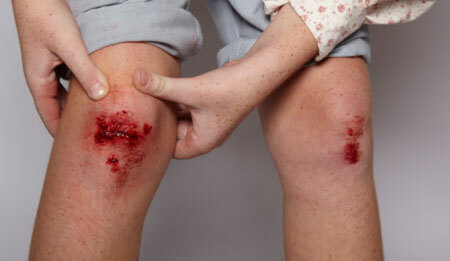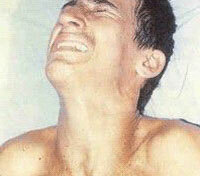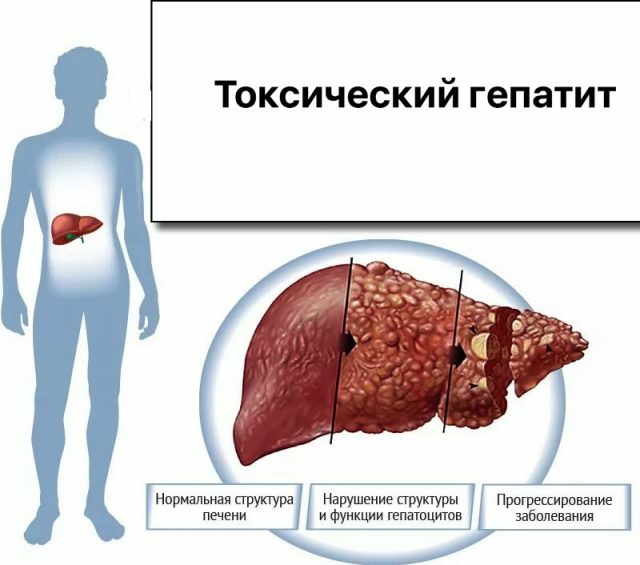Tetanus - tetanus is the most dangerous bacterial infection that releases a deadly toxin that causes functional disorders in the human CNS.
It is manifested by a syndrome of muscular hypertonia and attacks of rapid and prolonged convulsive symptoms. It is characterized by rapid development and manifestation of characteristic signs of the disease.
Table of Contents
- 1 Tetanus: How is infection?
- 2 First signs of tetanus, the development of the disease
- 3 Symptoms of tetanus in humans, photos
- 4 Stages of tetanus
- 5 Treatment for tetanus, preparations
- 5.1 Preventive measures
Tetanus: how does infection occur?

Genesis of tetanus development is due to the influence of the rod-shaped, spore-forming microorganism of the Clostridium family, characterized by high resistance to survival in various media. Successfully tolerates disinfection and the effect of high temperatures, is able to maintain pathogenicity( infectiousness) for many years.
It can be detected in a cloaca of birds, inseminated with spores of the earth, in dust particles and feces of various animals. Here it persists for a long time and successfully multiplies.
In the human body infection comes through a contact method, penetrating the bloodstream through the mucous membrane and wounds of any origin, whether it is a deep wound, or a puncture from a splinter. The main ways of infection with tetanus can be:
- operating and burn wounds;
- dog bites, wounds stabbed and wounded;
- wounds dental and frostbite;
- Infection of newborns through umbilical wound.
Agricultural workers and livestock keepers are at greatest risk of infection, adolescent boys due to excessive mobility, which causes frequent injuries.
Once infected with tetanus, does not mean that the body will develop immunity against it. Knowing how tetanus is transmitted, you need to protect yourself and your loved ones.
The first signs of tetanus, the development of the disease

The first signs of tetanus, photos - unexpected convulsions
The main symptoms of tetanus in man manifest fatigue and muscle pain. Eating is accompanied by difficulty swallowing. There is a febrile condition, palpitations and sweating. The first signs of tetanus begin to appear even a week after infection.
The starting point for the development of the disease is an easy spasm of the jaw and facial muscles. Sometimes the process can include: thoracic, cervical, dorsal, gluteal muscles and muscle tufts of the abdomen, accompanied by concomitant symptoms in the form of:
- high temperature indices;
- hypertonic signs;
- heart palpitations;
- convulsions.
The infectious process is caused by four main periods of the current - incubation( latent), initial, tetanus and the recovery stage. For each stage of development is characterized by its own symptomatology.
Features of the latent development of
In the period of latency, the infection does not show itself with pronounced symptoms. Recognize the disease is possible only after carrying out special tests. The severity of the manifestation of symptoms depends on the duration of the tetanus incubation period. The shorter this stage, the more pronounced are the signs of the disease.
The latency of infection is caused by different terms-from 2 days to a month. Usually the duration of the incubation stage does not exceed 14 days. Precursors of the disease( prodromal) can manifest themselves:
- muscle spasms( involuntary twitching);
- unnecessarily muscular tension in the area of injury;
- with migraines;
- with a vague sense of discomfort and irritability;
- with increased sweating.
Gradually, the prodromal symptoms become worse, followed by an acute clinical picture.
Symptoms of tetanus in humans, photo

Symptoms of tetanus in humans, photo 3
The onset of infection is characterized by a consistent sequence of tetanus symptoms that begin to manifest with a pain syndrome associated with the tension of the nerve fiber in the wound entry zone of the pathogen, even if the wound is already beginning to heal.
This is one of the earliest signs of tetanus in humans, indicating the emergence of a long infectious process.
Then follows the manifestation of tonic spasm of the muscles( trismus) of the temporomandibular zone, which limits the masticatory functions. The patient can not open his mouth freely, in difficult cases it can not be opened at all, because of the tightly compressed teeth.
An involuntary convulsive contraction of mimic facial muscles is noted, evoking on the face an expression of either a smile or a crying, merged into a single mask. The muscles of the occiput and pharynx are spasmodic, manifesting as symptoms of difficulty swallowing.
- A set of manifestations of such signs is found only in tetanus.
Signs of the height of the disease
 The peak in the development of tetanus symptoms in humans occurs at the height of infection, which can last from one and half to two weeks, depending on the severity of the process. At this stage, cramps are clearly manifested, which occur quite unexpectedly or grow gradually, lasting from a few seconds to a minute.
The peak in the development of tetanus symptoms in humans occurs at the height of infection, which can last from one and half to two weeks, depending on the severity of the process. At this stage, cramps are clearly manifested, which occur quite unexpectedly or grow gradually, lasting from a few seconds to a minute.
In this case, they can be of such intensity that they literally break a man - they tear tendons, twist joints and bones. There is a muscular tension that does not weaken even at night, and their soreness in the whole body.
Muscle tufts of the abdomen harden, brightly outlining the outline of muscles, motor activity is partially or completely blocked, the lower limbs freeze in an extended position. On the skin there are signs of cyanosis and a profuse sweat. The patient feels a strong deterioration of the condition, there are:
- signs of asphyxia, causing a violation of respiratory functions;
- apnea manifested by periodic blocking of respiration;
- disorders in the processes of urination and defecation, causing pain in the perineum;
- fever and copious salivation.
The lack of timely assistance and treatment for tetanus with symptoms of this intensity can end fatal.
Recovery process
Complete recovery is preceded by a long-term treatment of tetanus - up to two months. Gradually decreases the amount of convulsive symptoms. It is at this stage, against the background of an improved condition, that various complicated processes can develop:
- rigidity( rigidity) of the musculoskeletal system;
- muscular and articular ruptures;
- bone tissue damage;
- development of secondary bacterial infections( sepsis, pneumonia, pulmonary atelectasis, pyelonephritis);
- formation of phlegmon and abscesses in the "entrance gate" zone of the infection.
Stages of tetanus
The overall evaluation of tetanus in humans is based on the severity of clinical signs.
- The stage of easy flow lasts no more than three weeks. It is characterized by moderate spasms of the facial and dorsal muscles. Clonic-tonic cramps may be absent altogether. The temperature can stay within normal limits or be slightly overpriced. The general or common symptomatology is shown no more long week.
- The medium-heavy stage lasts from 2 to 3 weeks. All symptomatology manifests itself and grows within three days. Characterized by a convulsive syndrome, which occurs as long as once a day. Signs of hyperhidrosis, tachycardia and subfebrile condition remain in moderate limits.
- The stage of a severe infectious process is caused by a short latency - one, two weeks. The manifestation and growth of the main symptomatology occurs for two days, it is intense and pronounced. The stage of extremely severe disease is characterized by a very short stage of incubation( up to seven days) and the immediate development of regular, prolonged convulsive syndromes, up to five minutes, and muscle spasms accompanied by tachypnea( superficial rapid breathing), signs of tachycardia, suffocation and cutaneous cyanosis
Treatment of tetanus, preparations
 Due to the high risk of mortality in tetanus, patients are treated in a hospital with the assistance of an anesthesiologist. Patient creates conditions of rest and isolation from stimuli. The process of feeding is based on gastric sounding, or parenteral( intravenously), with paresis of the gastrointestinal tract.
Due to the high risk of mortality in tetanus, patients are treated in a hospital with the assistance of an anesthesiologist. Patient creates conditions of rest and isolation from stimuli. The process of feeding is based on gastric sounding, or parenteral( intravenously), with paresis of the gastrointestinal tract.
Carry out pressure sore treatment and wounds, through which the pathogen penetrated the body. Even if the wound is tight, it is cured with a special serum.
The wound is being inspected. In the area of infection localization, cuts are made, for oxygen access, the wound is treated and cleared from foci of necrosis.
Preparations for the treatment of tetanus:
- Enzyme preparations are introduced - "Trypsin" or "Chymotrypsin".It is very important, as soon as possible to enter into the body preparations of specific immunoglobulin or PS serum.
- As a symptomatic treatment used drugs relaxing muscles( muscle relaxants), psychotropic drugs, narcotic drugs. In severe cases - intravenously, "Diazepam", Combinations of drugs - "Aminazina" + "Promedola" + "Dimedrol".It is possible to add a prolonged solution of Scopolamine.
- Preparations of sedative effect in the form of "Seduxen", powders, syrups, aqueous solutions with "sodium Oxybutyrate".In severe cases - "Fentanyl", or "Droperidol".
- Of muscle relaxants, curare-like preparations - "Pankuronium", "Tubokurarin".
- With emotional instability - "Alpha and beta blockers."
- If the respiratory function is disturbed, intubation of the patient, artificial ventilation with oxygen, aspiration( mechanical cleansing) or hyperbaric oxygenation is performed.
- The problems of the gastrointestinal tract and urinary system are solved by the method of installing a gas outlet tube, by catheterization and laxatives.
- To prevent secondary infections, the curative plan includes antibiotic therapy.
- In case of acid-base imbalance and dehydration, correction is performed by intravenous injections - solutions of "Reopoliglyukin", "Albumin", plasma-substituting means "Gemodez-N".
The prognosis of the disease is due to the shape of the flow and the severity of the process. In the last severe stages of tetanus, with rapid development of symptoms, death is often due to untimely care and delayed treatment.
Mild forms of the disease, with appropriate treatment of pathology, are successfully cured.
Preventive measures
Prevention is based:
- for maximum injury prevention;
- competent processing and thorough disinfection of wounds and cuts;
- on early referral to the doctor for the treatment of deep and contaminated wounds;
- on the stage-by-stage routine tetanus vaccination and timely follow-up revaccination;
- on stimulation of immunity and emergency prevention in the shortest possible time.
It is from the right actions, in this or that traumatic situation, that sometimes our life depends.



